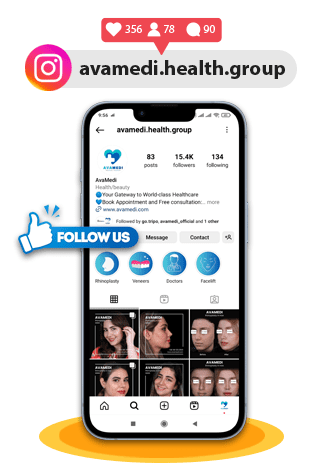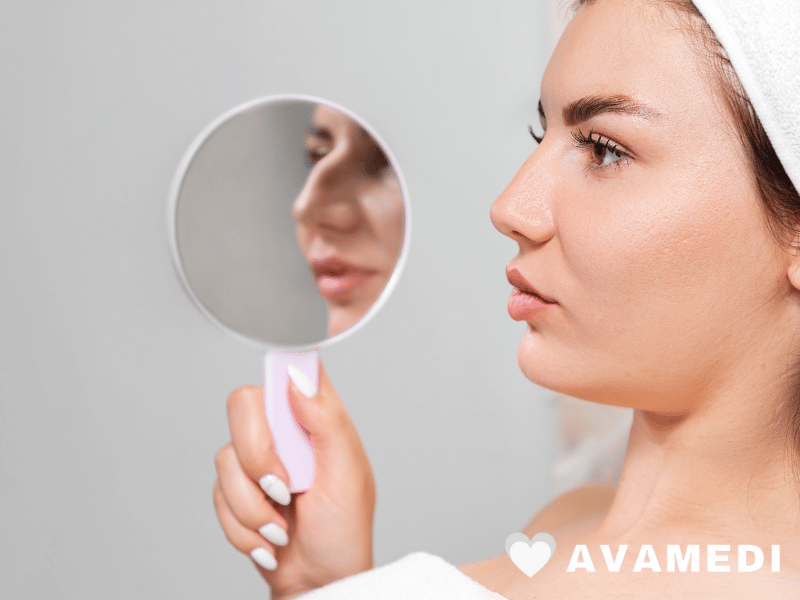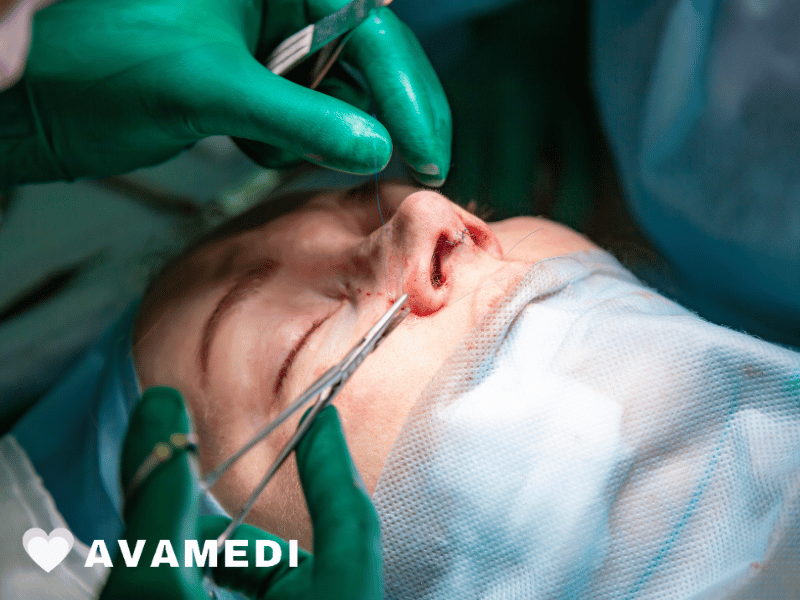The Arab nose shape is a distinct type of Middle Eastern nose shape. The Arab nose is known for its unique shape and structure. It has deep cultural and historical meaning. It is also important for personal and social views on beauty and identity.
In this article, we will explore the features of the Arab nose shape, its genetic background, and cultural views. We will also discuss the role of nose jobs for those who want changes.
Characteristics of the Arab Nose Shape
The Arab nose, often called the Middle Eastern or Semitic nose, usually has these features:
- Prominent Bridge: One of the most defining traits of the Arab nose shape is the high bridge, which can appear slightly curved or convex. This characteristic gives the nose a strong and distinctive profile.
- Nasal Hump: A small bump on the bridge, often called a dorsal hump, is common in Arab nose shapes. While it may vary in size, it is one of the most prominent features that differentiates it from other nose shapes.
- Broad Nasal Base: The width of the nasal base can differ. Many Arab noses have a slightly wider base than Caucasian noses. This characteristic adds a balanced, symmetrical look to the face.
- Downward-Tilted Nasal Tip: Many people with an Arab nose shape have a tip that points down. This can create a clear and elegant look. This feature often gives the nose a refined, slightly elongated look.
- Thicker Skin Texture: The skin on the Arab nose is usually thicker than on other noses. This thickness can make small changes in shape or contour more difficult. However, it also gives the nose a stronger, less fragile appearance.
Avamedi offers multiple other services, such as Rhinoplasty in Iran and Revision Rhinoplasty in Iran.
Historical and Cultural Significance of the Arab Nose
In many Middle Eastern cultures, the nose is seen as a prominent feature symbolizing strength, beauty, and identity. Ancient sculptures, carvings, and art from the area show people with prominent noses. This highlights the historical value placed on this feature.
The prominent nose is often seen as a sign of nobility and pride. Many traditional Arab and Mediterranean societies view it as a symbol of character and dignity.
In some areas of the Arab world, facial features are linked to family and heritage. People often feel proud if their nose looks like a parent’s or grandparent’s. This resemblance symbolizes family history and continuity. These cultural views affect how many see their nose. Some embrace it as a strong link to their roots and heritage.
Genetic Influences on the Arab Nose Shape
The structure and shape of the Arab nose are largely influenced by genetics, with ancestry playing a significant role. The Middle East and North Africa are genetically diverse regions with influences from African, Mediterranean, and Central Asian populations. This genetic diversity contributes to the variability in Arab nose shapes, with subtle differences across regions and ethnic backgrounds.
Some genetic traits, like a high nasal bridge and a dorsal hump, have been passed down through generations. This has led to the prominent nose shape often seen among Arabs.
Some studies suggest that nasal shapes have changed due to climate and environment. Larger noses may help warm and humidify the air before it reaches the lungs. This can provide an advantage in dry areas.
Also Read: Famous Celebrities Nose Job
Aesthetic Perceptions of the Arab Nose
Cultural standards deeply influence the perception of beauty and attractiveness; the Arab nose is no exception. In Western beauty standards, a smaller and more refined nose is often seen as ideal. This nose usually has a straight bridge and an upturned tip.
This aesthetic has permeated global beauty trends and influenced how individuals perceive their features, including the Arab nose shape.
However, attitudes are shifting, with greater appreciation emerging for diverse nose shapes and unique facial structures.
The growth of social media has helped change beauty standards. It allows people to share their experiences and support diversity. Many now see the Arab nose shape as a sign of beauty, strength, and authenticity. This shift helps challenge old beauty ideals.
Arab Nose Rhinoplasty: Understanding Arab Nose Surgery
Arab nose rhinoplasty, also known as Arab nose surgery, is a special type of surgery. It focuses on the unique shape and beauty of Middle Eastern or Arab noses.
This type of rhinoplasty is designed for common traits in Arab nose shapes. These traits include a prominent bridge, dorsal hump, thicker skin, and a downward-angled tip. For people of Arab descent, rhinoplasty helps them achieve their desired look or function. It also respects and preserves their cultural identity.
AvaMedi offers multiple other services, such as Nose Job in Turkey
The Role of Rhinoplasty in Arab Communities
Rhinoplasty, or nose reshaping surgery, is a very popular cosmetic procedure around the world. The Middle East is no exception. In countries with many Arab people, like Lebanon, Iran, and the United Arab Emirates, many seek rhinoplasty. They want to change the shape or structure of their nose.
The motivations for rhinoplasty can vary widely. Some people want small changes to improve their nose’s natural shape. Others may want more dramatic changes to meet certain beauty standards.
Rhinoplasty techniques for Arab noses are often tailored to fit the unique features of Middle Eastern noses. These techniques aim to create balance and harmony while respecting the person’s cultural identity.
Arab nose Job typically aims to:
- Refine the Dorsal Hump: The dorsal hump is the bump on the bridge of the nose. It is often softened or reduced to create a smoother look.
- Elevate or Define the Tip: Many Arab noses have a tip that angles down slightly. This tip can be refined or lifted for a balanced and attractive appearance.
- Narrow the Nasal Bridge: Some people want to make a wide nasal bridge narrower. This helps their facial features look more balanced.
- Preserve Cultural Features: Many Arabs consider it essential to retain the natural look and distinctiveness of their heritage. Skilled surgeons can balance these unique aspects while achieving subtle enhancement.
Specialized Techniques for Arab Nose Job
Arab noses have a unique structure. They have thicker skin and a more distinct shape. Because of this, surgeons use special techniques for rhinoplasty in Arab patients. Some of these techniques include:
- Open rhinoplasty is often used to give better access to the nose. This method allows for more precision. It is especially helpful when reshaping or reducing the dorsal hump.
- Tip Refinement and Rotation: For patients who want a lifted tip without big changes, surgeons can adjust the cartilage. They can also move the tip to a better angle.
- Septoplasty for Breathing Issues: When structural problems cause breathing difficulties, septoplasty can help. This procedure corrects the septum to improve airflow.
A primary consideration in Arab nose surgery is preserving the patient’s cultural identity. Skilled surgeons understand that many Arab patients wish to refine rather than radically alter their appearance.
By respecting these preferences and aiming for natural results, they can help patients achieve beauty that honors their heritage.
Ideal Candidates for Arab Nose Rhinoplasty
Ideal candidates for Arab nose rhinoplasty include individuals who:
- Seek a natural, balanced enhancement to their nose shape
- Experience functional issues, such as breathing difficulties, that can be addressed during rhinoplasty
- Have realistic expectations about the results, aiming for subtle refinement rather than complete transformation
- Desire results that complement their other facial features and reflect their cultural heritage
Types of Rhinoplasty for Arab Nose Shapes
When thinking about rhinoplasty for an Arab nose, there are several options. These depend on the person’s goals, facial structure, and desired results.
- Reduction Rhinoplasty: For those who want to reduce the size of the dorsal hump or create a more refined tip, reduction rhinoplasty is commonly used. This type of surgery can reduce the prominence of the nose without sacrificing its natural contour.
- Augmentation rhinoplasty is a procedure some patients choose. They want to make certain parts of their nose larger, such as the nasal bridge. This can help create a more balanced look. In these cases, augmentation techniques using grafts or fillers can enhance the shape.
- Tip Refinement: Individuals who want subtle improvements without changing their entire nose shape often choose tip refinement. This technique reshapes the nasal tip. It creates a balanced and harmonious look that matches the rest of the face.
- Non-Surgical Rhinoplasty: For those seeking minimal alterations, non-surgical rhinoplasty with dermal fillers can be an effective option. This procedure involves injecting fillers to adjust the shape, often reducing the appearance of humps or lifting the tip. While temporary, this option offers a non-invasive solution for minor reshaping.
Middle Eastern countries are home to some of the highest rates of rhinoplasty in the world. Countries such as Lebanon and Iran have earned a reputation for being at the forefront of cosmetic surgery, with many patients seeking rhinoplasty to achieve their ideal look.
For some people, the goal is not to erase their Arab nose. Instead, they want to refine or enhance it. They aim to keep their cultural features intact.
The high demand for rhinoplasty in these areas has led to new techniques for the Arab nose. Surgeons in the Middle East are skilled at working with thick-skinned noses and fixing dorsal humps. They help patients reach their aesthetic goals while keeping a natural appearance.
The Arab Nose in Art and Media
Art and media have long played a role in shaping society’s views on beauty, and the representation of the Arab nose has evolved over time.
Contemporary media has been increasingly pushing to include diverse representations, including actors and models with Arab nose shapes. This representation has helped promote acceptance and redefine beauty standards by showcasing the Arab nose shape in a positive light.
As more people see diverse facial features in the media, they become more likely to embrace their own unique appearance.
Also Read: Exploring Aquiline Nose: Ethnicity and Comparisons
Conclusion
The Arab nose shape is a distinct and culturally rich feature that carries deep-rooted significance for Middle Eastern and North African individuals.
Ultimately, the Arab nose shape is a unique and beautiful trait contributing to the diverse landscape of human facial features. Whether through art, cultural heritage, or personal empowerment, it stands as a testament to the importance of embracing one’s individuality.
As more people challenge traditional beauty norms, the world moves closer to a more inclusive, accepting view of beauty that honors and celebrates every individual’s unique background.




















